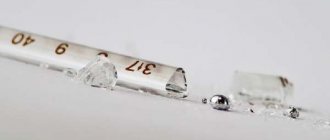Acetic acid
Acetic acid poisoning is life-threatening. Accidental or intentional use of the substance causes burns to the mucous membrane, severe intoxication of the body, and swelling of the respiratory tract.
Symptoms of poisoning depend on the amount and concentration of vinegar. If vinegar essence (30-80%) is drunk, a person experiences a painful shock, he cannot breathe, swallow, and loses consciousness. Bloody vomiting may occur. With a small amount of table vinegar drunk (3-9%), a strong burning sensation in the throat, pain in the stomach, weakness occurs, the poisoned person’s consciousness becomes confused, the voice becomes hoarse, and difficulties arise with breathing and swallowing.
You need to act very quickly. First of all, we call an ambulance. Then the person needs to be given some water to rinse his mouth. Place the victim on their side to avoid vomit entering the respiratory tract. It is strictly forbidden to rinse the stomach on your own or induce vomiting.
Main types and properties of vinegar
Acetic acid is a food preservative with a complex chemical molecular structure. There are the following varieties:
- Apple cider vinegar essence in minimal concentration brings only help to the human body. Traditional medicine recommends drinking a solution of a teaspoon of apple cider vinegar in a glass of clean, cool water on an empty stomach as an anti-inflammatory and antibacterial agent. Intoxication of the body begins when consuming 100 ml of pure 5% apple cider vinegar essence. Possible burns to the esophagus, gastric mucosa and damage to internal organs.
- Wine vinegar in small doses serves as an excellent preventive measure for diseases of the cardiovascular system. Widely used in preparing Japanese dishes. It has a bright tart aroma. An overdose, dangerous to health, occurs when taking more than 30 ml of 5% essence.
- Doctors prohibit the consumption of balsamic vinegar even in tiny quantities by people with diseases of the gastrointestinal tract. Despite its bright taste properties, poisoning with an overdose occurs most quickly.
- Table vinegar is a 9% solution of acetic acid. This is the most dangerous solution, as it usually has an extremely high concentration of acid (15% and above). It should be carefully protected from children and not stored at all in a house where there are mentally ill people. People who are prone to this kind of behavior often prefer to poison themselves with table vinegar. The lethal dose of such a solution, provided the acid concentration is 10-15%, is 100-150 ml.
Video: what happens if you drink a bottle of vinegar
Read further:
Oxygen cocktail: benefits and harm for the body of children and pregnant women
10 ways to strengthen your immune system
When is hospitalization necessary for high blood pressure?
How to quickly induce vomiting after eating at home for weight loss
Oxygen intoxication - symptoms and treatment methods
Article rating:
( 1 ratings, average: 5.00 out of 5)
Share with friends:
You may also be interested in:
Lethal dose of coffee for humans: in cups, spoons
What to do in case of coffee overdose
Horse chestnut poisoning - symptoms and treatment
Protein poisoning: symptoms, causes and consequences
Why is it used in cooking?
Acetic acid is a colorless liquid with a pungent odor and tart taste. Mixes to a homogeneous consistency with many solvents. Unintentional ingestion of pure essence is difficult due to the strong odor of this acid and serious irritant effect on the respiratory tract. Alas, poisoning with vinegar essence is one of the most common causes of household mortality.
Vinegar essence is widely used when preparing dough products (together with baking soda - as a leavening agent). Experienced housewives use it when kneading dough for pancakes, the base for homemade pizza, adding tart flavor notes to rice, and soaking cold cuts before frying shish kebab.
How to neutralize vinegar?
A chemical neutralization reaction is a reaction between an acid and a base that produces salt and water. The neutralization reaction itself can be observed only if an indicator is added to the acid solution, which changes the color of the solution. As soon as you add alkali to a colored solution, the color will immediately disappear.
One option for neutralizing vinegar is a sodium hydroxide (NaOH) solution. For this:
- Fill special chemical flasks with a diluted solution of sodium hydroxide and acetic acid.
- Add a few drops of an indicator, such as phenolphthalein, to a flask with sodium hydroxide (you can also add a catalyst).
- Then add acid to the alkali solution, carefully one drop at a time.
- Continue adding the acid solution until all the sodium hydroxide is converted to salt.
Important! You can observe this transition by a change in the color of the indicator: the crimson color of the solution will completely disappear, and the liquid will become transparent.
Modern method of acid neutralization
In the event of an accident and a spill of acetic acid, production uses a more modern method of neutralizing acetic acid, using an automated packaging machine. All acid-contaminated surfaces are treated with anhydrous powdered sodium carbonate.
This treatment of the contaminated surface is carried out until a thick paste is formed, and the paste itself is not removed. During subsequent acid spills onto the pan and in the event of the appearance of a liquid phase, the spill sites are again treated with sodium carbonate until a paste appears that binds the liquid phase. If acid gets on a surface located outside the pan, this can be corrected by neutralizing with water until a solution with a concentration of 25-30% is obtained.
Important!
Acetic acid can be neutralized with only two alkalis: this can be either sodium carbonate or sodium hydroxide. Acetic acid is a fairly aggressive chemical. Therefore, to avoid consequences, when using it, be sure to follow safety precautions and our recommendations. When working with acid, be sure to use gloves to protect your hands and do not overdo the concentration. Remember, it is always easier to prevent a problem than to fix it later.
Possible causes of intoxication
People often drink vinegar solutions when they are heavily intoxicated. They are the ones who are unable to sense the pungent smell and sour taste. It often happens that a drunk person wants to achieve even greater euphoria, and in search of funds he decides to do desperate things. Many uneducated people still believe that vinegar essence can increase the strength of an alcoholic drink. Of course, this opinion is completely wrong.
The second reason is taking vinegar in high dosages due to lack of awareness. This is typical for children and adolescents. For example, apple cider vinegar has a rather pleasant aroma (especially the 5% solution) and kids may think it is juice.
In some cases, poisoning by vinegar essence vapors in culinary and technological production is possible. This is a direct failure to comply with safety instructions.
Effects of vinegar on the body
On supermarket shelves the product is stored in a concentration of 5-10%. The lethal dose of 10% vinegar is about 200 ml (this amount varies depending on gender, weight and health status). In production and professional restaurants, they can use essence with a concentration of up to 70% - the dose of such a solution that is dangerous to health is even smaller - about 20-50 ml.
You should not try to use vinegar for medicinal purposes on your own. Even a relatively safe solution of apple cider vinegar essence in small quantities can lead to intoxication in people with chronic liver and thyroid diseases.
The first symptoms of poisoning with vinegar essence
What you should pay attention to first (external manifestations of intoxication):
- the person does not have enough air, he begins to breathe greedily;
- the skin turns pale, and a bright red border forms around the lips;
- fever, slight chills;
- in some cases - severe nausea, vomiting;
- profuse salivation.
Here are the medical signs of vinegar essence poisoning:
- the composition of the blood changes: destruction of red blood cells with the release of hemoglobin;
- liver and kidney failure develops rapidly;
- extensive burns of the esophagus and gastric mucosa;
- unbearable burning pain in the patient (occurs when taking large doses of vinegar essence);
- blood clotting disorder.
Consequences and prevention
Vinegar poisoning does not go away without leaving a trace, even if it was in a mild form. The consequences of such intoxication may not appear immediately, but after some time. What can happen after poisoning?
What happens:
- disruption of the digestive system, scar formation, problems with nutrition and digestion of food,
- bleeding in the esophagus,
- serious blood loss
- dysfunction of the liver, kidneys,
- swelling of the lungs, disturbances in the respiratory process,
- exacerbation of chronic diseases,
- weight loss,
- the occurrence of malignant tumors,
- pulmonitis, bronchitis.
A fully cured person may, after some time, face the negative consequences of poisoning. It is possible to avoid intoxication if you follow safety precautions.
Prevention measures:
- In production, it is required to use protective equipment when working with acetic acid. (occupational poisoning - more details)
- Before diluting the essence, you need to accurately calculate the proportions; it is better to perform the procedure with gloves.
- Vinegar must be stored in places where children and animals cannot find it.
- When using acid for disinfection, it is recommended to thoroughly ventilate the room.
- When used for culinary purposes, do not exceed the required dosage.
Acetic acid poisoning often ends in the death of the patient. If negative symptoms are detected, immediately call a doctor and provide emergency care to the injured person. With proper treatment, recovery occurs, but serious consequences cannot be ruled out.
Methods for detecting intoxication
An experienced doctor will easily make the correct verdict in a matter of seconds. A pungent odor from the mouth, the characteristic appearance of the victim and complaints will leave no doubt about the diagnosis. According to the ICD code, poisoning with vinegar essence is labeled T54.2.
In some cases, the time to save the victim takes a matter of minutes. There is no time to do blood tests, urine tests and wait for the results. Therefore, it is important to be smart and not hesitate. Acute poisoning with vinegar essence often ends in death.
Even an untrained person, far from medicine, will not be difficult to guess the reason for the poor health or excruciating pain of the victim. To do this, it will be enough to lean towards his face - the vinegar smell will clearly be heard from his mouth.
Clinical picture of poisoning
Vinegar poisoning can be fatal within the first 5 days. Surviving patients become disabled (in 99% of cases).
The clinical picture is usually as follows:
- The first 5-10 days. The so-called acute period. The victim feels unbearable pain in the mouth, throat and lower esophagus. Damage to the vocal cords leads to hoarseness and loss of voice. Salivation increases and the swallowing reflex is impaired. Periodically, vomiting occurs, often mixed with scarlet blood. Vapors of acetic acid, penetrating the respiratory tract, cause swelling, difficulty breathing, and pneumonia.
- 30 days. If the victim survives, then after the acute period his general condition improves - the pain subsides, he begins to drink and eat on his own. There are no scars yet, but there is a rejection of dead (burnt) tissue. This process is dangerous due to perforation of the walls of the esophagus, bleeding, infection, and the development of pneumonia.
- 2-4 months - 3 years. During this period, the damaged tissue is replaced by connective (scar) tissue. As a result, the esophagus becomes narrowed (stricture), and its ability to contract and stretch is lost. The swallowing reflex is disrupted, food ceases to be digested properly. Late symptoms of vinegar poisoning: heartburn, increased salivation, putrid breath, belching, vomiting, discomfort and stomach pain.
Three degrees of complexity of acetic acid intoxication
Medicine distinguishes the following degrees of damage to the body:
- mild degree is characterized by a low degree of intoxication, superficial burns of the esophagus, mild chills, nausea;
- with a moderate degree, the stomach is significantly damaged, blood thickening occurs and acute renal failure may develop;
- severe degrees often lead to death due to failure of the liver, gallbladder, and other organs of the gastrointestinal tract; this degree is characterized by serious burns of internal organs; the patient vomits profusely, loses consciousness, and experiences excruciating pain.
Providing first aid to the victim
Algorithm of action if you suspect a person has been poisoned by vinegar essence:
- Call an ambulance by phone.
- Rinse your mouth with clean cool water and try to rinse your throat. This should not be done if the patient is in agony and is experiencing severe pain.
- You should not try to “quench” an acid reaction using baking soda (a common mistake).
- You cannot give any pills before the doctors arrive, and you are prohibited from eating any food.
- Carry out the gastric lavage procedure at home (if the first aid provider has the necessary qualifications).
Help for poisoning with vinegar essence should first of all be guided by the rule “do no harm.” Attempts to give the patient a solution of soda, vegetable oil and other means of “folk methods of neutralizing vinegar” to drink can lead to even greater complications. If the ambulance takes a long time to get to the scene of the incident, it is best to describe the degree of intoxication over the phone and follow the instructions of the doctors.
What to do if you are poisoned by vinegar and its vapors?
Category: Chemical poisoning
Vinegar (acetic essence or acid) is stored in the kitchen of almost every housewife. It is used in households for pickling, canning, baking or as a cleaning agent. In this case, the concentration of the solution depends on the scope of its use.
Poisoning with vinegar essence can occur due to careless handling of the substance or occur intentionally (for example, taking vinegar for the purpose of suicide). This condition poses a serious danger to human health; the pathological process can result in dire consequences, including death.
This article will examine in detail whether it is possible to be poisoned by vinegar, what symptoms appear, and how this condition can end.
How does vinegar affect the body?
When consumed internally, acetic essence (acid) has both local and general resorptive effects.
- local exposure provokes chemical burns of the mucous surface of the digestive tract, their swelling and inflammation;
- the general resorptive effect is associated with the ability of acetic acid to be quickly absorbed into the blood, which causes hemolysis (disintegration) of red blood cells. This leads to the formation of hematin hydrochloride crystals in the acidic renal environment, clogging the renal tubules. All this provokes the development of serious kidney diseases.
Hemolysis of red blood cells also leads to disruption of the blood coagulation system. In fact, when poisoning with vinegar, a burn disease develops.
Is death possible?
A 9% concentration of table vinegar in a small amount will not cause serious harm. But large dosages and use of a solution of 30% or more can lead to serious consequences. In some cases, even lethal escape is possible.
The following complications are fatal in case of acetic acid poisoning:
- active effect of the substance on tissue, causing the development of painful shock;
- loss of large amounts of fluid and internal bleeding;
- violation of the acidic environment in the body;
- dysfunction of the renal system;
- abnormalities in liver function caused by blockage of blood vessels;
- damage to vital systems and organs.
Severity of poisoning
Vinegar poisoning can have varying degrees of severity. It all depends on the amount of dangerous substance that enters the body.
Experts distinguish 3 degrees of severity of vinegar intoxication:
- mild - develops when consuming 15-40 ml of vinegar solution;
- medium – occurs after taking 40-70 ml of the substance;
- severe - occurs after about 70-250 ml enters the body. acetic acid.
Symptoms of poisoning
Symptoms of vinegar poisoning are conventionally divided into two groups:
- initial;
- resorptive.
Initial signs include:
- numerous chemical burns of the mucous surface of the oral cavity, larynx, and digestive tract;
- acute pain in the oral cavity, in the retrosternal area and epigastrium;
- repeated vomiting;
- the presence of blood in the vomit;
- severe abdominal pain associated with irritation of the peritoneum;
- wheezing (stridor) breathing, accompanied by noise;
- swelling of the larynx;
- hoarseness of voice;
- excessive salivation;
- dyspnea;
- pungent (unpleasant, chemical) odor from the mouth;
- red urine.
Resorptive signs of poisoning begin to develop some time later, when the dangerous substance is absorbed into the bloodstream. These symptoms include:
- development of acute nephrosis (kidney disease);
- azotemia (increased levels of nitrogenous products in the blood);
- anuria (lack of urine flow into the bladder);
- hepatopathy (liver damage);
- disruption of the hemostasis system.
First aid
Acetic acid poisoning is a pathological process that disrupts the functioning of all internal organs. To prevent dangerous consequences, it is important to provide timely assistance to the victim.
Let's consider what needs to be done if symptoms of vinegar poisoning are detected:
- You should rinse your mouth with clean water (room temperature). This water should not be swallowed; it must be spat out.
- You can put ice on the abdominal area. Cold slows down the absorption of acid into the blood plasma from the gastric mucosa. Or you should suggest that the patient chew 2-3 pieces of ice.
- In case of severe pain, it is allowed to use Almagel A, which contains anesthesin.
- It is strictly forbidden to wash the stomach using the “restaurant” method or give the poisoned person drugs to induce vomiting.
- Under no circumstances should you take a soda solution orally, as soda and acetic acid will cause a chemical reaction with the formation of large amounts of carbon dioxide. This will cause the stomach to expand and injure the digestive tract.
Features of treatment
Vinegar poisoning cannot be treated at home! It can lead to burn injuries and serious complications. Calling an ambulance is a necessary condition for maintaining the health of a poisoned person. In a hospital setting, the necessary treatment method will be selected taking into account the clinical picture of the disease.
First of all, medical workers take the following measures:
- Rinse the stomach through a tube using saline solution.
- Painkillers are administered intravenously to eliminate severe pain. For example: Caver, Ketorolac, Promedol.
- Antiemetics are used: Ositron, Cerucal, Metoclopromide.
- Plasma or plasma-substituting solutions are administered intravenously.
- Corticosteroids are used to prevent the development of severe shock. This could be: Dexamethasone, Prednisolone.
- To replenish the volume of lost fluid and relieve symptoms of intoxication, solutions such as Disol, Trisol are administered intravenously.
- For laryngeal edema, hormonal irrigation or tracheotomy is used.
Also additionally carried out:
- hormone therapy;
- physiotherapy;
- correction of progressive deviations;
- prevention of complications.
Possible consequences
1-3 hours after vinegar enters the body, 10% of those poisoned develop acute perforations (the integrity of the esophagus and stomach is compromised).
The following consequences may develop later:
- gastrointestinal bleeding;
- the antrum of the stomach and esophagus narrows due to rough scarring of burn sites;
- pneumonia (aspiration);
- chronic renal failure;
- suppuration of burn injuries;
- purulent inflammation of the trachea or bronchi;
- chronic gastritis;
- inflammation of the esophagus;
- exhaustion of the body and weight loss;
- disturbance of acid-base balance and protein metabolism.
The prognosis of poisoning with a vinegar solution depends on the quality of care provided, the amount of the substance taken, as well as on the changes that have occurred in the body.
The most life-threatening period is the initial period of poisoning - the first day after vinegar enters the body, when death is possible due to exotoxic shock or peritonitis.
Prevention measures
To prevent vinegar intoxication, you must follow a number of safety rules:
- If possible, do not keep (store) solutions of vinegar essence at home. It is best to immediately after purchase dilute the vinegar with water (in a ratio of 1:20) or buy ready-made table vinegar;
- It is imperative to store the vinegar solution out of the reach of children, for example, on the top shelves of a kitchen cabinet;
- When using vinegar solution in the process of pickling or canning food, you should strictly adhere to the recommended dosage.
If vinegar enters the body in large quantities, it poses a serious threat to human life and health. Poisoning from vinegar vapors is also dangerous. Such a pathological process can result in numerous burn injuries to the respiratory and digestive organs, as well as disrupt the functioning of the entire body. Therefore, self-medication for this type of poisoning is unacceptable! Consult a doctor – don’t make the situation worse!
poisoning.info
Basic treatment methods
Treatment for poisoning with vinegar essence consists of reducing the toxic effect of the acid on internal organs.
First of all, this is gastric lavage. Then honey. the worker will intravenously administer special antidotes that can neutralize the destructive effects of the poison.
Taking sodium bicarbonate to restore the acid-base balance is possible only under the supervision of experienced physicians, as it can cause an unexpected allergic reaction.
Further treatment is aimed at restoring damage after toxic shock. This is the healing of internal burns, restoration of the functioning of damaged organs and systems.
Preventive measures
The basic rule of prevention: do not store concentrated solutions of vinegar essence at home! There's no point in even buying them. As a last resort, if there was no low-concentrated solution on the store shelf, dilute the essence yourself with clean water. This will not make it lose its properties.
Even after this, vinegar should not be stored in accessible places (especially if there are children or people with mental disabilities in the house who are not aware of their actions).
The bottle should be tightly sealed to prevent accidental spillage and gradual evaporation.
Help me, what to do, I poured vinegar into the salad. It’s a pity to throw it away. Maybe someone knows how to help?
It's easy and interesting to communicate here. Join us!
make more salad and give away the excess.
for example, you put too much sand in tea, it is very sweet, add tea and dilute it to taste!
Scum in a colander))
RINSE THROUGH A COLANDER.
prepare more ingredients. or just throw it away
make another salad and mix
A salad is a mixture of different foods. Add anything you like, chopped potatoes, eggs, cucumber, carrots, you can even boiled fish, herbs, radishes. It will turn out a lot and tasty.
Add baking soda - it neutralizes the acid.
Place in a colander under cold water. Rinse lightly and then season to taste.
Pour in sunflower oil.
Into the rakrivina - under the water. Just make sure no one sees it!
Consequences of poisoning with vinegar essence
Each case is individual and depends on the age, gender and initial health status of the patient. After receiving complex intoxication, the patient faces lifelong disability. Even timely, competent rehabilitation measures are not always able to radically change the situation.
Here are some common effects of poisoning:
- acute renal failure;
- burn of the esophagus and gastric mucosa;
- mechanical asphyxia;
- resection of part of the stomach and intestines.
First aid for poisoning with vinegar essence and timely calling an ambulance can help save the patient’s life. Gastric lavage when first degree intoxication occurs is usually sufficient. If damage to organ tissue has begun, it will be very difficult to stop the process. Approximately 14% of all recorded cases of vinegar essence poisoning are fatal.
When is medical attention required?
As soon as it is discovered that a large amount of vinegar has been ingested, you should immediately call an ambulance or take the victim yourself to the nearest emergency room.
Upon admission, the patient immediately undergoes gastric lavage through a tube, using at least ten liters of clean water.
Further treatment includes:
- prescription of narcotic and/or non-narcotic analgesics;
- carrying out forced diuresis with alkalization of blood plasma;
- vitamin therapy;
- taking protein hydrolysates and blood products.
With the development of acute renal failure, accompanied by hyperkalemia, a significant increase in the content of urea and creatinine in the blood serum, hemodialysis is indicated.
Severe breathing disorders caused by burns and swelling of the larynx may require urgent tracheostomy with subsequent transfer of the patient to mechanical ventilation.
Treatment of exotoxic shock is carried out according to generally accepted algorithms in the intensive care unit and resuscitation department.










